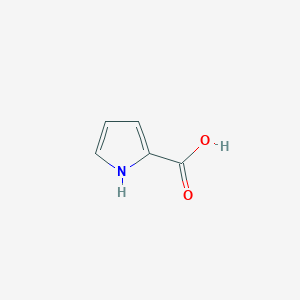| General Information of MET (ID: META00532) |
| Name |
Pyrrole-2-carboxylic acid
|
| Synonyms |
Click to Show/Hide Synonyms of This Metabolite
1H-Pyrrole-2-carboxylic acid; 1H-Pyrrole-2-carboxylic acid (9ci); 2-Minaline; 2-Pyrrolecarboxylate; 2-Pyrrolecarboxylic acid; 2-Pyrrolecarboxylic acid, monosodium salt; Minalin; Minaline; PCA; PYC; Pyrrole-2-carboxylate; Pyrrole-2-carboxylic acid
|
| Source |
Endogenous;Food
|
| Structure Type |
Pyrrole carboxylic acids and derivatives (Click to Show/Hide the Complete Structure Type Hierarchy)
Organoheterocyclic compounds
Pyrroles
Pyrrole carboxylic acids and derivatives
|
| PubChem CID |
|
| HMDB ID |
|
| Formula |
C5H5NO2
|
| Structure |
<iframe style="width: 300px; height: 300px;" frameborder="0" src="https://embed.molview.org/v1/?mode=balls&cid=12473"></iframe>
|
 |
|
3D MOL
|
2D MOL
|
|
Click to Show/Hide the Molecular/Functional Data (External Links/Property/Function) of This Metabolite
|
| KEGG ID |
|
| DrugBank ID |
|
| ChEBI ID |
|
| FooDB ID |
|
| ChemSpider ID |
|
| METLIN ID |
|
| Physicochemical Properties |
Molecular Weight |
111.1 |
Topological Polar Surface Area |
53.1 |
| XlogP |
0.8 |
Complexity |
103 |
| Heavy Atom Count |
8 |
Rotatable Bond Count |
1 |
| Hydrogen Bond Donor Count |
2 |
Hydrogen Bond Acceptor Count |
2 |
| Function |
Pyrrole-2-carboxylic acid was synthesized over a century ago, but its history as a compound of biological origin is rather recent. It was first identified as a degradation product of sialic acids, then as a derivative of the oxidation of the D-hydroxyproline isomers by mammalian D-amino acid oxidase. The latter relationship results from the lability of the direct oxidation product, A'-pyrroline-4-hydroxy-2-carboxylic acid, which loses water spontaneously to form the pyrrole. A similar reaction is catalyzed by the more specific allohydroxy-D-proline oxidase of Pseudomonas. In whole animal observations, pyrrole-2-carboxylate (PCA) ' was identified in rat or human urine after administration of the D-isomers of hydroxyproline, a finding ascribable to the action of D-amino acid oxidase. Urinary excretion of N-(pyrrole-2-carboxyl) glycine has been reported in a 5-year-old affected with type II hyperprolinemia; The child has mild developmental delay, recurrent seizures of the grand mal type and EEG alterations. The urinary excretion of the conjugate is stressed, since it appears that only one previous report in the literature described this compound in the urine of two patients affected by this disturbance.
|
|
Regulatory Network
|
|
|
|
|
|
|
|
|
 click to show the details of this protein
click to show the details of this protein
 click to show the details of experiment for validating this pair
click to show the details of experiment for validating this pair

